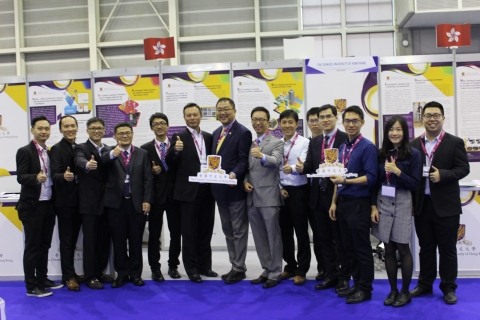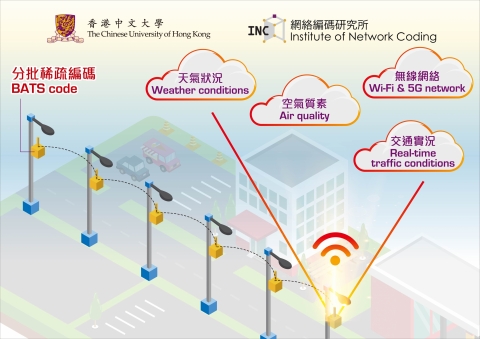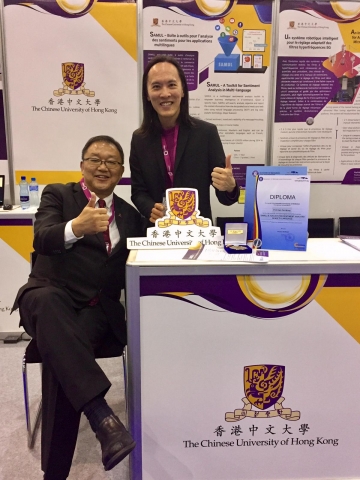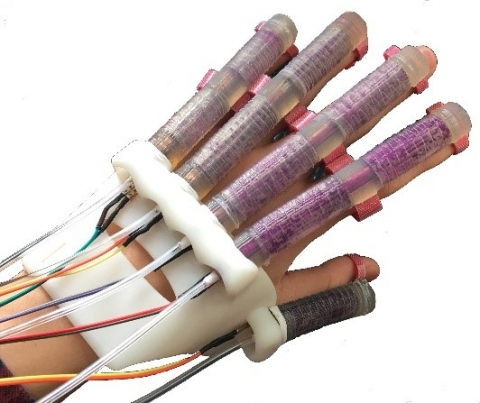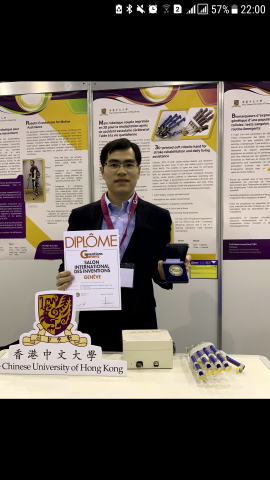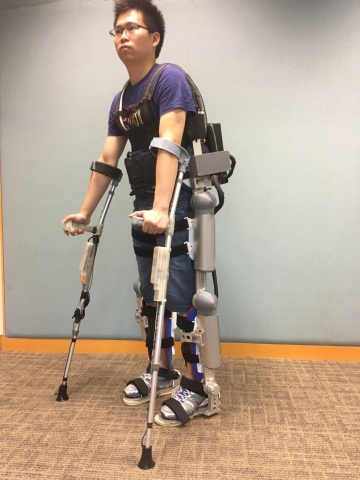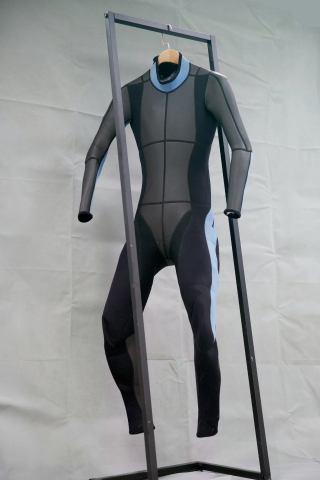Eleven Engineering projects have received two Gold Medal with Congratulations of the Jury, one Gold Medal, seven Silver Medals and the Prize of the Ministry of Scientific Research and Innovation - Romania in the 47th International Exhibition of Inventions of Geneva. Here is a summary of the Faculty of Engineering’s award-winning projects: Gold Medal (Gold Medal with Congratulations of the Jury) Team members: Prof. YANG Shenghao and Prof. YEUNG Wai Ho Raymond, from the Institute of Network Coding Project: BATS: Enabling the Nervous System of Smart Cities BATS, a revolutionary network coding technology, has been adopted in the Hong Kong Government’s pilot deployment of smart lampposts that will commence in mid-2019. BATS can provide multi-hop wireless network connections for smart lampposts without laying optical fiber to every lamppost. Laying new optical fiber, even if feasible, will require much construction work and severely disturb traffic and pedestrians. On the other hand, BATS enjoys the advantages of a low operating cost and a higher level of network security and stability. It provides a city-friendly and economical solution for mass deployment of smart lampposts, and so it expedites the advent of smart cities and and improves people’s quality of life. Team members: Prof. Philip Wai Yan CHIU, from the Department of Surgery, Faculty of Medicine, Prof. Yeung YAM and Dr. Ka Chun LAU, from the Department of Mechanical and Automation Engineering, Faculty of Engineering Project: Endoscopic Surgical Robot This is a fully flexible endoscopic surgical robotic system for Endoscopic Submucosal Dissection of tumor and early cancer in the stomach and colon. The two flexible robotic arms can overcome limitations from the lack of maneuverability of the current tool (such as the size and strength of the arms) and perform challenging procedures to increase the safety and efficiency of surgery. The project enabled the performance of endoscopic surgery without incision and reduced pain and discomfort after surgery, leading to faster recovery of the patient. Multiple times pre-clinical trials showed that this invention reduces operation time by two thirds and it did not cause any perforation in any trials. Gold Medal Team member: Nezha (by Dr. Gabriel FUNG, from the Department of Systems Engineering & Engineering Management, Faculty of Engineering, with technology licensed by CUHK) Project: Nezha – an AI-driven Checkbot for proof reading Chinese Nezha is an AI-driven Chinese language Checkbot to help people proofread Chinese. It is built from a proprietary data algorithm using advanced natural language processing (NLP) technology. Its lexicon contains billions of Chinese vocabulary (more than 100GB). The name is taken from the God “Nezha” in the Chinese novel “Creation of the Gods” in terms of its power to identify various mistakes and to make appropriate corrections. Nezha conducts its work on the cloud. It is the first of its kind in the market with its advantages of high accuracy, fast analytic time and ease to use. Silver Medal and Prize of the Ministry of Scientific Research and Innovation – Romania Team members: Prof. WONG Kam Fai, Dr. Gabriel FUNG, Mr. Bo LI and Mr. Felix LIU, from the Department of Systems Engineering & Engineering Management, Faculty of Engineering Project: SAMUL – A Toolkit for Sentiment Analysis for Multilanguage Application SAMUL is a multilingual sentiment analysis toolkit. Given a specific topic, SAMUL will search, analyse, organise and report the related information from the designated social media and websites using natural language processing (NLP) and big data analytic technology. The analysis by SAMUL includes extracting the credibility, content and mood of the author of a message. Currently, SAMUL can read Cantonese, Mandarin and English, but can be extended to other alphabetic languages. During 2014–2016, the research team surveyed six of its major clients and the accumulated revenue boost made by SAMUL was USD$25 million. SAMUL is protected by 5 patents (three accepted and two pending). Silver Prize Team member: Prof. Cheng Chun Hung, former Professor, from the Department of Systems Engineering & Engineering Management, Faculty of Engineering; Director of Research and Technology Development, Logistics and Supply Chain Multitech R&D Centre Project: Smart Traffic Light System on Dam Section of Tai Tam Road The smart traffic lights system has solved the long-standing traffic deadlock and traffic jam at Tai Tam Road (Dam Section) in one go. It can detect vehicle types and dimensions, analyse the traffic flow and traffic queue length data, and then calculate the most effective green signal time according to the real-time traffic condition. Team members: Prof. TONG Kai Yu Raymond, Mr. HEUNG Ho Lam and Mr. TANG Zhi Qiang, from the Department of Biomedical Engineering, Faculty of Engineering and Prof. LI Zheng, Department of Surgery, Faculty of Medicine Project: 3D-printed soft robotic hand Stroke, the leading cause of disability, has drawn more attention in view of the aging population. A personalised multi-functional soft robotic hand has been developed for daily recovery training purposes, allowing patients to reintegrate into society after the training. The feature of the soft robotic hand is the patented design of the Soft-Elastic Composite Actuator (SECA) which assists stroke patients in performing effective finger flexion and extension. Compared with the conventional metallic robotic hand, the soft robotic hand can assist patients in performing more hand function tasks to aid their daily lives; for example, gripping a pen and wringing a towel. Team members: Prof. LIAO Wei Hsin, Mr. ZHONG Chunhao and Mr. ZHAO Xuan, from the Department of Mechanical and Automation Engineering, Faculty of Engineering, Prof. QIN Ling and Dr. LAW Sheung Wai, from the Department of Orthopaedics and Traumatology, Faculty of Medicine Project: Robotic Exoskeleton for Motion Assistance The project was developed to help paralysed patients stand up and walk. Hip and knee joints were equipped with powerful actuators. A magneto-rheological (MR) series elastic actuator was designed for the exoskeleton which can generate large controllable braking torque while consuming little energy. A lightweight “cable-spring” mechanism was utilised to solve foot-drop problem, which can improve the safety level for the user. Novel MR actuators can improve energy efficiency by 53%, and extend the working time of batteries by up to 112%. The system of exoskeleton and crutches is equipped with multiple sensors, combined with an intelligent controller, to provide safe and effective motion assistance to the user. Team members: Prof. Charlie C.L. WANG, Dr. Yunbo ZHANG, Dr. Tsz Ho KWOK and Mr. Mark Hoi SHEUNG, from the Department of Mechanical & Automation Engineering, Faculty of Engineering Project: Shape-driven Design and Manufacturing Technology for Industry 4.0 The project leverages on core technology driven by shape and optimised production design to provide advanced and intelligent C2M manufacturing solutions and data to wearable product manufacturers in order to achieve Industry 4.0. The project helps reduce the manufacturing time from 2-3 weeks to 2-3 days. It is suitable for the ultra-personalised 3D wetsuit, tailored suits, shoes and functional underwear with improved fit and comfort. The auto intelligent design can be transferred to fit different individuals. It also has the new optimised surface flattening technology. Team members: Prof. WU Ke Li, Dr. MENG Huan, Mr. WEI Dacheng and Mr. HUNG Winghung, from the Department of Electronic Engineering, Faculty of Engineering Project: An Intelligent Robot System for Adaptive tuning of 5G Microwave Filters With the fast pace of mobile communication system development, the quantity for microwave filters is increased unprecedentedly. The complicated and slow manual tuning process as well as the shortage of experienced filter tuning technicians are two major obstacles that lead to low production capacity. This invention, which employs the analytic circuit model extraction theory originally developed in CUHK and the adaptive optimisers, can automatically tune filters with the speed that is multiple fold faster than manual tuning process. Additionally, the system provides a one-stop solution for big data analytics and quality inspection in the filter tuning process. Its unique capability in compensating for the hysteresis effect in tightening filter tuning screws allows the system to meet various challenging specifications. Another unique feature is its ability to diagnose the defects in the assembling process of production and to provide remedy instructions. The system has been used in the production lines for 5G base stations in a large scale. Team members: Prof. Tien-Tsin WONG and Dr. Wuyao SHEN, from the Department of Computer Science and Engineering, Faculty of Engineering Project: Binocular Single Vision on Entertainment and Medical Applications Human eyes are capable of fusing two displaced images, even those with differences in details, contrast and luminance, up to a certain limit. This phenomenon is binocular single vision, based on which the team developed the world’s first Binocular Video Tone Mapping (BVTM) framework. Additionally, an AI-based self-learning mechanism has been invented and embedded within the framework, performing critical functions including automatic parameter adjustment and outcome optimisation. As for applications, the BVTM framework can be adopted in the Hollywood 3D film-making industry by generating videos whose quality, vividness, realism and other attributes are beyond what is currently possible. In ophthalmologic examinations, the technology can be applied to Amblyopia (Lazy Eye) treatment. Team members: Prof. Cheng Chun Hung, former Professor, from the Department of Systems Engineering & Engineering Management, Faculty of Engineering and Director of Research and Technology Development, Logistics and Supply Chain Multitech R&D Centre; Mr. Tim Chan and Dr. Dorbin Ng, from the Department of Systems Engineering & Engineering Management, Faculty of Engineering Project: Smart Landslide Detection System Mountainous terrain covers 60% of the land area of Hong Kong, and landslides may happen under conditions of continuous rainfall. If early signs of debris flow are not detected, it might cause casualties and losses. A smart landslide detection system is developed to monitor real-time terrain conditions and transmit wireless data to the mobile devices of duty staff, using low-cost and low-energy sensing devices.
|
|

